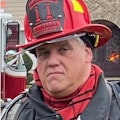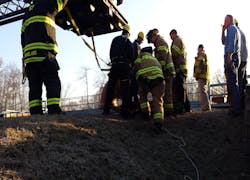Lessons Learned from 'Routine' Confined Space Incident
On the morning of Jan. 17, 2014, at the United Water – Water Treatment facility in Manalapan, NJ, an employee walking the perimeter of the facility overheard someone shouting for help. He and a few other workers discovered a man had climbed into a 20-inch diameter pipe that serves as an outflow pipe from a storage facility on site. The pipe empties into a drainage basin at the facility. The victim entered the basin, entered the first section of piping, and traversed the horizontal pipe section until he entered a vertical section, dropping him 12 feet underground at the bottom of the pipe, head first.
Upon receipt of the initial 9-1-1 call, the communications center dispatched the local fire department and rescue squad. After establishing command, the decision was made to reach out to the closest rescue team. At 7:35 a.m., command requested resources from local and state technical rescue teams.
It became apparent early into the operation that any success would require the first sections of the pipe assembly to be removed to allow direct overhead access to the victim. That would make removal of the victim easier than manipulating the victim through the pipe (see Photo 1).
With additional rescue personnel responding, on-scene operations focused on pipe removal for the entry. Layouts of the pipe system and victim location were identified and representatives from the rescue teams met with the operations officer at the top of the pipe to aid in the rescue. As the pipe sections were removed, operations were underway to improve conditions within the space for the victim.
By 11:20 a.m., the victim was removed and transported to the landing zone, loaded onto a waiting medevac helicopter and flown to the nearest trauma center for treatment.
At 11:42 a.m., command was terminated, and all resources were cleared from the scene.
Lessons learned
Considering the complexity and the dynamics of the incident, a few points were raised for consideration and remediation:
Patient contact relies directly on the accessibility to the patient—Responders were unable to make entry into the pipe the same way the victim did and remove the victim once they were packaged. However, this situation is not rare; many times, additional steps are necessary to gain access into the space to perform the rescue. In this case, the pipe extended upwards from a berm that provided a support wall for the retention basin. The proximity to the basin made for muddy soil around the pipe, which made tool stabilization and operation from the ground level difficult. Secondly, the top of the berm meant that there was limited space for rescuers to operate, and equipment on top of the berm was limited to what was in use at that time (see Photo 2).
Additionally, finding a suitable overhead anchor for the operation would prove to be challenging. The pitch of the walls around the pipe would not allow mounting a rigid overhead anchor with significant stability, so an overhead anchor from an aerial device was to be used. The last elbow of pipe was proving to be a formidable opponent; years of exposure to the elements and to moisture had seized the sections of pipe together at the expansion joint. Efforts were put into placing a relief cut into the bezel of the pipe to remove the elbow to gain access to the victim.
Consider the incident was almost five hours, but patient treatment and removal took less than 30 minutes. Most of the time spent on scene was dedicated to cutting, lifting, moving, and disassembly operations (see Photo 3). It is imperative that rescuers be trained not only in the steps of the entry and removal, but also possess the skills necessary to move large objects, remove significant components, and “solve problems” that would hinder an entrant to perform rescue.
Will you need to disassemble or destroy the equipment to access the patient?—Brute strength and hasty actions are no match for mastery of skill. To truly maximize the time spent without waste during an operation, responders shall be experts in the skills needed to perform their duties. Technical rescues and high-risk operations are time-driven, limiting the time of exposure for both the rescuers and the victims assures successful outcomes. The best way to limit the time of exposure is to have a mastery of one’s responsibilities at the incident (see Photo 4).
Are you making things worse with your operations?—A decision was made to put a relief cut in the pipe at the joint to relieve the pressure on the pipe. A gas-powered rotary saw was brought up to the pipe and cutting operations began. During the cut, a considerable increase in carbon monoxide (CO) was identified in the space, so the gas-powered tools were replaced with an electric reciprocal saw to finish the cut (see Photo 5). Additionally, weather conditions that day were sunny and in the low 30s. The patient was underground, in a cast-iron pipe laying in silt and water. Efforts to provide warm air were established with a propane-powered Rehab Heating unit. This became problematic, as an increase in CO was identified during the warming process. Blankets and towels to aid in warming the victim were utilized to minimize any atmospheric hazard.
Patient care needs to begin as soon as possible, within the hot zone—The location of the victim, along with the limited access in the space, limited treatment that could be provided to the patient by only one entrant. In considering that, the people who would provide the rescue must have some type of emergency medical training. Entrants performing the rescue should be able to provide treatment and packaging for safe removal of the injured victim from any rescue situation (Photo 6).
Assign a safety officer at every incident—In the hot zone, the safety officer can provide critical feedback to the incident command staff. Additionally, NFPA 1670 (2017), Operations and Training for Technical Search and Rescue Incidents, states in section 4.5.2, “The incident commander shall assign a member to fulfill the duties of a safety officer…” with the knowledge, skills and abilities to identify and correct safety issues within the operation. To not have one watching over the incident can be a recipe for disaster.
Conclusion
There is a danger when emergency responders start to view incidents as “routine” calls. Granted, there may be incidents that do not result in immediate and vital actions to save lives on every call; but that does not mean that we do not prepare for every run as if we will be performing these skills. It is imperative that we stay vigilant, trained, and ready in anticipation for anything that we are summoned to do. Staying ready keeps responders safe and provides the best service for the customers we are sworn to protect.
Until next time, stay focused and stay safe.
About the Author

Michael Daley
MICHAEL DALEY, who is a Firehouse contributing editor, recently retired as a 37-year veteran who served as a captain and department training officer in Monroe Township, NJ. He is a staff instructor at multiple New Jersey fire academies and is an adjunct professor in the Fire Science Program at Middlesex County College. Daley is a nationally known instructor who has presented at multiple conferences, including Firehouse Expo and Firehouse World. His education includes accreditations as a Chief Training Officer and a Fire Investigator, and he completed the Craftsman Level of education with Project Kill the Flashover. Daley is a member of the Institution of Fire Engineers and a FEMA Instructor and Rescue Officer with NJ Urban Search and Rescue Task Force 1. He operates Fire Service Performance Concepts, which is a training and research firm that delivers and develops training courses in many fire service competencies.
